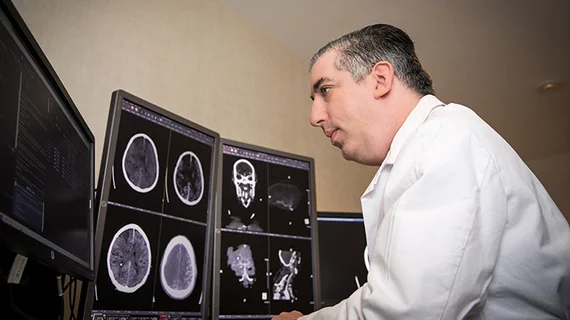Radiologists must change their approach to stroke care in the AI era
As artificial intelligence continues to play a larger role in stroke care, radiologists have the unique opportunity to redefine their role in patient care and distance themselves from the concept of the “invisible” radiologist.
“There have been endless debates and discussions on whether AI will replace radiologists. We, as radiologists, assert that AI will not replace us, but rather augment our intelligence and workflow," Achala Vagal, MD, and Luca Saba, MD, both from the Department of Radiology at the University of Cincinnati Medical Center, recently wrote in an editorial in Radiology. "But when an AI application such as that in Code Stroke changes clinical practice, are we equipped to adapt?”
Caring for ischemic stroke patients requires rapid, accurate and efficient care, and involves a multidisciplinary team of physicians, radiologists, nurses, surgeons and techs. AI’s role on the stroke team has recently increased, proving to be immensely beneficial for improving workflows, detecting pathologies invisible to the human eye and offering decision-making support in time-sensitive triage situations.
Smartphone applications utilizing AI, meanwhile, helps providers easily communicate, and can send out alerts with detailed image findings within minutes of of a scan being completed. These results can be accessed anywhere from a mobile device, expediting diagnosis to treatment times like never before.
However, the authors noted that depending on AI as a standalone reader inevitably results in medical errors, which has bred skepticism among many in the imaging community, as those medical errors can be life-threatening for patients.
“It is important to understand the intended clinical use of the technology,” the doctors explained. “The best use case scenario is not autonomous AI, but rather AI partnered with human supervision.”
To coalesce radiologists growing presence on the care team with emerging AI solutions for stroke, the authors suggest that radiologists think about adapting their own practices. This could include using designated mobile devices to keep in constant contact with the stroke team and increasing their familiarity with the various algorithms used for identifying multiple stroke pathologies.
“Radiologists have an opportunity to situate themselves at the center of patient care, but it will require transforming the operational framework and rebranding ourselves. Otherwise, we may lose the potential to add value where it matters,” the doctors concluded.
Related Stroke Imaging Content:
Automated CT scoring system accurately predicts prognosis in stroke patients
New CT protocol uses scout images to expedite stroke patients' path to MRI
What decades of data tell us about stroke rates in the U.S.
Most Americans live within an hour of a stroke center
FDA warns providers about potential misuse of imaging-based software for stroke triage
Radiologists must change their approach to stroke care in the AI era
MRI findings associated with poor thrombectomy outcomes after stroke
Risk of recurrent stroke 48% higher among young marijuana users

